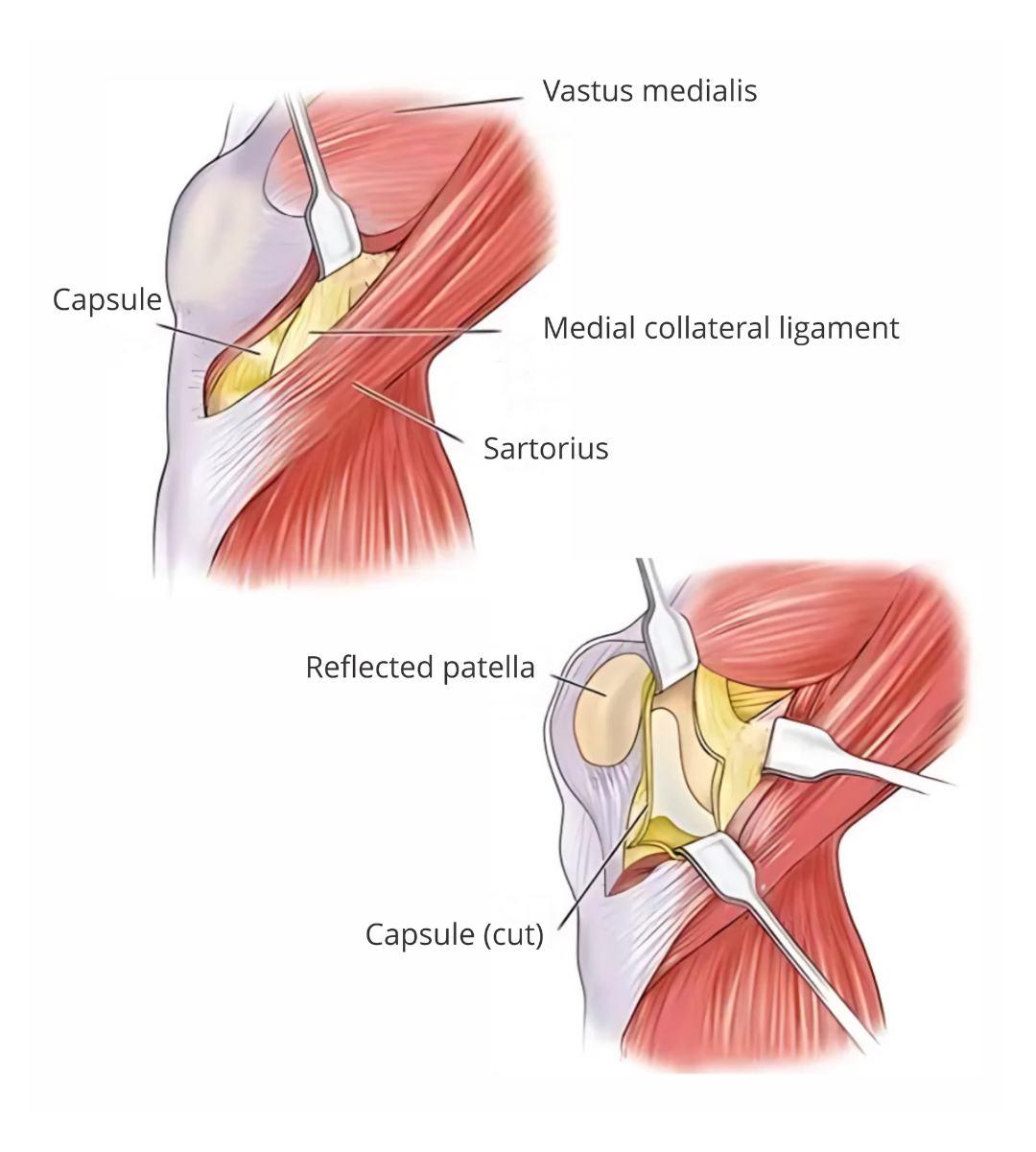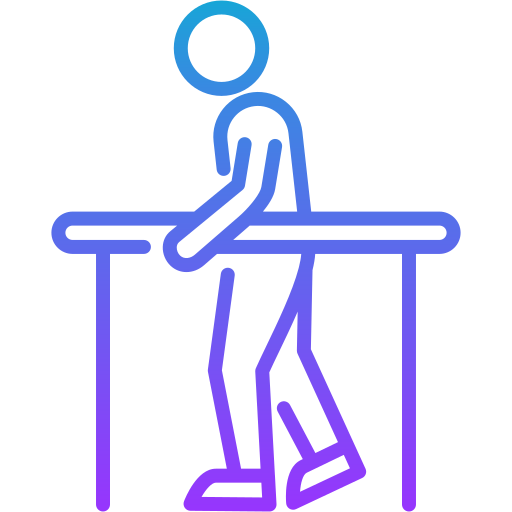Dr. Apoorv Dua
Rediscover Mobility with Advanced Joint Replacement at Dr. Dua’s Speciality Clinic
- Expert Joint Replacement – Specialized Knee, Hip & Shoulder Care
- Minimally Invasive Surgery – Less Pain, Faster Recovery
- Personalized Rehab Plans – Tailored Physio for Quick Mobility
- Advanced Technology – Precision Surgery, Lasting Results
- Compassionate Care – Support from Surgery to Full Recovery
Consult a Doctor

MISCR Knee Replacement
MISCR Knee surgeons DO NOT cut the Quadriceps or the VMO muscles. Rather we use special instruments and techniques to “lift” the muscle and slide it. Only the skin and capsule are cut. Surgery time typically takes 30 minutes to implant. LESS PAIN and QUICKER RECOVERY
Dr. Apoorv Dua, recognized as one of the best orthopedic doctors in South Delhi, brings extensive expertise in diagnosing and treating knee-related issues. With a commitment to providing top-notch care, he utilizes advanced techniques and state-of-the-art technology to address knee problems effectively. Whether dealing with arthritis, ligament damage, or other knee ailments, Dr. Dua’s approach combines precision and personalized care to achieve optimal outcomes for his patients.
Know More
About MISCR Knee Replacement
-
 Symptoms
Symptoms
-
 Diagnosis
Diagnosis
-
 How We Perform
How We Perform
-
 Why Is Treatment Needed?
Why Is Treatment Needed?
-
 Recovery
Recovery
-
 Rehabilitation
Rehabilitation
-
 Prevention
Prevention
MISCR Knee replacement is often considered when symptoms from knee conditions become severe and affect daily life. Common symptoms that may indicate the need for a knee replacement include:
Key Points:
- Persistent knee pain that does not improve with medication or physical therapy.
- Significant swelling and stiffness in the knee joint.
- Reduced range of motion, making it difficult to bend or straighten the knee.
- Pain that interferes with sleep or daily activities.
- Difficulty walking or bearing weight on the affected leg.
Diagnosing the need for a MISCR knee replacement involves a thorough evaluation of symptoms, physical examination, and imaging studies to assess the extent of joint damage.
Key Points:
- Detailed medical history and symptom review.
- Physical examination to evaluate knee function, alignment, and tenderness.
- X-rays to visualize bone structure and detect arthritis or joint damage.
- MRI or CT scans for a more detailed view of soft tissues and cartilage.
- Assessment of functional limitations and impact on quality of life.
The MISCR knee replacement procedure involves replacing the damaged knee joint with an artificial implant to restore function and alleviate pain. The process is performed using advanced techniques to ensure optimal outcomes.
Key Points:
- Anesthesia is administered to ensure the patient is comfortable and pain-free during the surgery.
- An incision is made to access the knee joint, and the damaged cartilage and bone are removed.
- The artificial knee implant is precisely positioned to restore joint function.
- The incision is closed with sutures or staples, and a bandage is applied.
- Post-surgery, the knee is monitored and managed for pain and swelling.
MISCR knee replacement is often necessary when other treatments fail to relieve pain and improve mobility. The procedure helps address severe knee joint damage and improve overall quality of life.
Key Points:
- Alleviates severe pain that impacts daily activities and quality of life.
- Restores knee function and mobility, enabling a return to normal activities.
- Reduces the risk of further joint damage and complications.
- Provides long-term relief for conditions like osteoarthritis and rheumatoid arthritis.
- Improves overall physical health and mental well-being by reducing chronic pain.
The MISCR Knee procedure is a type of knee replacement surgery that’s designed to help patients recover faster and with less pain than traditional knee replacements.
Key Points:
- Patients can typically walk within an hour of the procedure, and are usually off a walker and driving within a week. They can resume normal activities in about six weeks.
- The miscr Knee procedure is designed to reduce post-operative pain.
- Patients work with home physical therapy for 10 days, and then start outpatient physical therapy around 10-14 days.
- The miscr Knee procedure preserves muscles and tendons, which reduces soft tissue trauma and promotes faster recovery.
Rehabilitation is a crucial part of the recovery process, focusing on exercises and therapy to strengthen the knee and restore its function.
Key Points:
- Physical therapy to improve range of motion and strength in the knee.
- Customized exercise programs to address specific recovery goals.
- Techniques to enhance balance and stability.
- Regular assessments to track progress and adjust therapy as needed.
- Education on proper techniques and activities to support long-term knee health.
While MISCR knee replacement addresses existing damage, preventive measures can help maintain joint health and reduce the risk of future issues.
Key Points:
- Regular exercise to strengthen muscles supporting the knee.
- Maintaining a healthy weight to reduce stress on the knee joints.
- Using proper techniques during physical activities to avoid injury.
- Wearing supportive footwear and avoiding high-impact activities when possible.
- Early intervention for knee problems to prevent progression to severe conditions.

HIP Replacement
Total hip replacement surgery is a highly effective procedure used to alleviate pain and improve mobility for patients suffering from hip joint damage or arthritis. Traditionally, the surgery involved making a large incision, dissecting muscle, and removing damaged bone, leading to longer hospital stays, extended recovery periods, and more significant post-operative discomfort. However, advancements in medical technology have paved the way for minimally invasive hip replacement surgery, which has become a preferred option due to its numerous benefits.
Minimally Invasive Hip Replacement Surgery uses smaller incisions and causes less disruption to the surrounding muscle and tissue. As a result, patients experience reduced pain, faster recovery times, and a shorter hospital stay, making it an excellent alternative to traditional hip replacement surgery.
Know More
About Hip Replacement
-
 Symptoms
Symptoms
-
 Diagnosis
Diagnosis
-
 How We Perform
How We Perform
-
 Why Is Treatment Needed?
Why Is Treatment Needed?
-
 Recovery
Recovery
-
 Rehabilitation
Rehabilitation
-
 Prevention
Prevention
Hip joint problems usually present with symptoms like persistent pain, stiffness, or discomfort in the hip, groin, or thigh area. Patients may also experience difficulty walking, reduced range of motion, and pain during weight-bearing activities like climbing stairs or sitting down.
Key Points:
- Persistent hip pain, especially during movement or after physical activity.
- Stiffness in the hip, groin, or thigh, limiting range of motion.
- Difficulty walking or climbing stairs without discomfort.
- Pain that radiates to the knee or lower back.
- Pain or discomfort that persists even when resting or sitting.
Diagnosis involves a thorough physical examination by your doctor, combined with imaging techniques like X-rays and MRI scans to assess the extent of joint damage. This allows the doctor to determine whether hip replacement surgery is necessary or if alternative treatments might be more suitable.
Key Points:
- A physical examination to assess range of motion and joint function.
- X-rays to evaluate bone structure and detect joint damage.
- MRI scans to assess cartilage and soft tissue damage.
- Blood tests may be performed to rule out infections or other conditions.
- A thorough medical history to understand symptoms and activity levels.
In minimally invasive hip replacement surgery, small incisions are made to access the hip joint. Damaged cartilage and bone are removed, and an artificial joint made of metal, plastic, or ceramic is implanted. The procedure minimizes tissue disruption, which helps in quicker recovery and reduced post-operative pain.
Key Points:
- Minimally invasive approach with small incisions to access the hip joint.
- Removal of damaged bone and cartilage from the hip joint.
- Placement of a prosthetic joint made of metal, ceramic, or plastic.
- Reduced tissue damage for less post-operative pain and quicker recovery.
- Surgery typically lasts 1-2 hours, with most patients discharged in 2-4 days.
Hip replacement surgery is crucial when joint damage becomes severe, causing chronic pain and impairing mobility. Left untreated, hip joint damage can lead to further complications, affecting the patient’s overall quality of life. The surgery helps restore function, relieve pain, and enhance the ability to perform everyday tasks.
Key Points:
- Severe pain that interferes with daily activities and quality of life.
- Loss of mobility, making it difficult to walk, sit, or stand comfortably.
- Risk of joint damage worsening over time if left untreated.
- Alleviates chronic pain caused by arthritis or injury.
- Surgery restores joint function, allowing for a return to normal activities.
Recovery after hip replacement typically involves a hospital stay of 2-4 days. Patients are encouraged to walk with assistance shortly after the procedure. Full recovery can take 6-12 weeks, depending on the individual, but most people return to their regular activities within this time.
Key Points:
- Initial hospital stay of 2-4 days, depending on individual recovery.
- Patients typically begin walking with assistance within 24-48 hours.
- Full recovery takes 6-12 weeks with proper rehabilitation.
- Pain management includes medication and physiotherapy.
- Gradual return to daily activities as strength and mobility improve.
Rehabilitation is a critical part of the recovery process. A personalized physical therapy plan helps to restore strength and range of motion in the hip joint. Exercises focus on improving mobility, stability, and balance. Adherence to the rehabilitation program is essential for optimal recovery outcomes.
Key Points:
- Personalized physical therapy plan to strengthen the hip joint.
- Focus on exercises that improve mobility, stability, and balance.
- Regular follow-up appointments to monitor progress.
- Home exercises to continue strengthening after therapy sessions.
- Commitment to rehabilitation significantly enhances recovery outcomes.
Preventing future hip issues involves maintaining a healthy weight, staying active, and engaging in low-impact exercises to strengthen the muscles surrounding the hip joint. Proper posture and avoiding activities that put excessive strain on the hips are also essential in reducing the risk of further joint problems.
Key Points:
- Maintain a healthy weight to reduce pressure on hip joints.
- Engage in low-impact exercises like swimming or cycling to strengthen hip muscles.
- Avoid high-impact activities that put excessive strain on the hips.
- Practice proper posture to prevent joint deterioration over time.
- Regular check-ups and early intervention can prevent further hip issues.

Shoulder Replacement
Shoulder replacement removes damaged areas of bone and replaces them with parts made of metal and plastic (implants). This surgery is called shoulder arthroplasty (ARTH-row-plas-tee).
The shoulder is a ball-and-socket joint. The round head (ball) of the upper arm bone fits into a shallow socket in the shoulder. Damage to the joint can cause pain, weakness and stiffness.
Shoulder implants are available in a few different shapes and a range of sizes. Replacement options include partial and total using either anatomic or reverse implants.
Shoulder replacement surgery has a high success rate, with patients often experiencing significant pain relief and improved mobility. Satisfaction rates for shoulder replacements are around 90%.
Know More
About Shoulder Replacement
-
 Symptoms
Symptoms
-
 Diagnosis
Diagnosis
-
 How We Perform
How We Perform
-
 Why Is Treatment Needed?
Why Is Treatment Needed?
-
 Recovery
Recovery
-
 Rehabilitation
Rehabilitation
-
 Prevention
Prevention
Shoulder replacement surgery is done to relieve pain and other symptoms that result from damage to the shoulder joint.
Conditions that can damage the joint include:
- Osteoarthritis: Known as wear-and-tear arthritis, osteoarthritis damages the cartilage that covers the ends of bones and helps joints move smoothly.
- Rotator cuff injuries: The rotator cuff is a group of muscles and tendons that surround the shoulder joint. Rotator cuff injuries sometimes can result in damage to cartilage and bone in the shoulder joint.
- Fractures: Fractures of the upper end of the humerus may require replacement, either as a result of the injury or when the prior surgery for fracture fixation has failed.
- Rheumatoid arthritis and other inflammatory disorders: Caused by an overactive immune system, the inflammation associated with rheumatoid arthritis can damage the cartilage and occasionally the underlying bone in the joint.
- Osteonecrosis: Some types of shoulder conditions can affect blood flow to the humerus. When a bone is starved of blood, it can collapse.
A doctor diagnoses conditions that may require shoulder replacement surgery by performing a physical exam, taking X-rays, and sometimes ordering other tests:
Physical exam
The doctor will check for any visible abnormalities or changes in the shoulder, and note pain levels during rest and activity.
X-rays
X-rays can confirm arthritis by showing loss of joint space in the shoulder joint.
CT scan
A CT scan may be needed to evaluate bone integrity.
MRI
An MRI can assess the condition of soft tissues, such as the rotator cuff tendon.
EMG test or nerve conduction study
If the doctor suspects nerve damage, they may order an EMG test or nerve conduction study.
Shoulder replacement surgery is a procedure that involves replacing the ball and socket of the shoulder joint with a prosthetic:
- Anesthesia
- Cut
- Remove the old parts
- Insert the new parts
- Close the incision
A shoulder replacement is a surgical procedure that replaces a damaged shoulder joint with an artificial component to treat pain and dysfunction. It’s often recommended when other treatments have failed and the patient is still experiencing severe pain and loss of function.
Some reasons why a shoulder replacement might be needed include:
- Arthritis
- Shoulder instability
- Severe pain
- Previous injuries
- Avascular necrosis
Shoulder replacement recovery varies from person to person, but it typically takes three to six months to fully recover.
Key Points:
- Pain and swelling: You can expect pain and swelling to taper off within the first four days.
- Physical therapy: You’ll start physical therapy within a week or two to help strengthen your shoulder muscles and improve movement.
- Activities: You should avoid activities that involve reaching or using your shoulder a lot, lifting heavy objects, or making sudden movements. You should also avoid putting your arm behind your back or using it to push yourself up
- Blood thinners: If you take a blood thinner, you should follow your doctor’s instructions carefully.
- Pain medication: Your doctor will tell you when and how to take pain medication.
Rehabilitation focuses on restoring shoulder function through physical therapy. This includes range of motion exercises, strength training, and pain management. The goal is to regain strength, flexibility, and stability in the shoulder. Functional activities are gradually reintroduced to help you return to daily tasks and activities with improved shoulder health.
Key Points:
- Tailored exercises to regain strength and mobility.
- Specific movements to improve shoulder flexibility.
- Exercises to rebuild shoulder strength and stability.
- Techniques and medications to manage post-rehabilitation discomfort.
- Gradual reintroduction to daily tasks and activities.
Preventing shoulder injuries involves regular exercise to strengthen the shoulder muscles, using proper techniques during physical activities, and avoiding overuse. Warm-up and stretching exercises help prepare the muscles for activity, while ergonomic adjustments ensure proper alignment and posture during daily tasks, reducing the risk of injury.
Key Points:
- Strengthening shoulder muscles to prevent injuries.
- Using correct techniques during physical activities and sports.
- Preventing repetitive strain on the shoulder joint.
- Preparing muscles before intense activities.
- Proper alignment and posture during daily tasks.
WHY US?
Why Choose Dr. Apoorv Dua
At our clinic, Dr. Apoov Dua offers expert care for Total Knee Replacement Surgery. With extensive experience in orthopedic surgery, Dr. Dua utilizes advanced techniques to ensure a smoother recovery and optimal long-term results.

70,000+
Patients Experience

25,000+
Procedures

60,000+
Trauma surgeries

5000
Joint Replacement Surgeries
Check Surgery Cost
We believe in transparency. You can enquire about the Surgery Cost and we will help you with complete detailed treatment process till your recovery.
Frequently Asked Questions
The biggest difference is preserving the soft tissue of your muscles and your tendons by not cutting them during the surgical exposure.
The risks of knee replacement done traditionally versus miscr is the same.
Yes, but not all surgeons will utilize a robot. Studies have shown there’s no better outcomes with robotic surgery versus non-robotic surgery.
Total hip replacement surgery involves replacing the damaged hip joint with a prosthetic joint made of metal, ceramic, or plastic, improving mobility and relieving pain caused by arthritis or injury.
Candidates include individuals with severe hip pain, joint stiffness, and limited mobility due to arthritis, injury, or degeneration, especially when non-surgical treatments have not provided relief.
Full recovery takes around 6-12 weeks, though most patients can walk with assistance within a few days and resume normal activities within 3 months, depending on rehabilitation.
This surgery replaces the ball-and-socket joint of the shoulder with metal and plastic parts. It’s usually used as a last resort to treat severe damage, deformity, or chronic pain.
Shoulder replacement surgery is very successful at relieving pain, but it’s not perfect. You might still feel some pain when the weather changes or if you’re too active. The amount of improvement in range of motion is less predictable than pain relief.
What Our Patients Say
Based on 160 reviews









